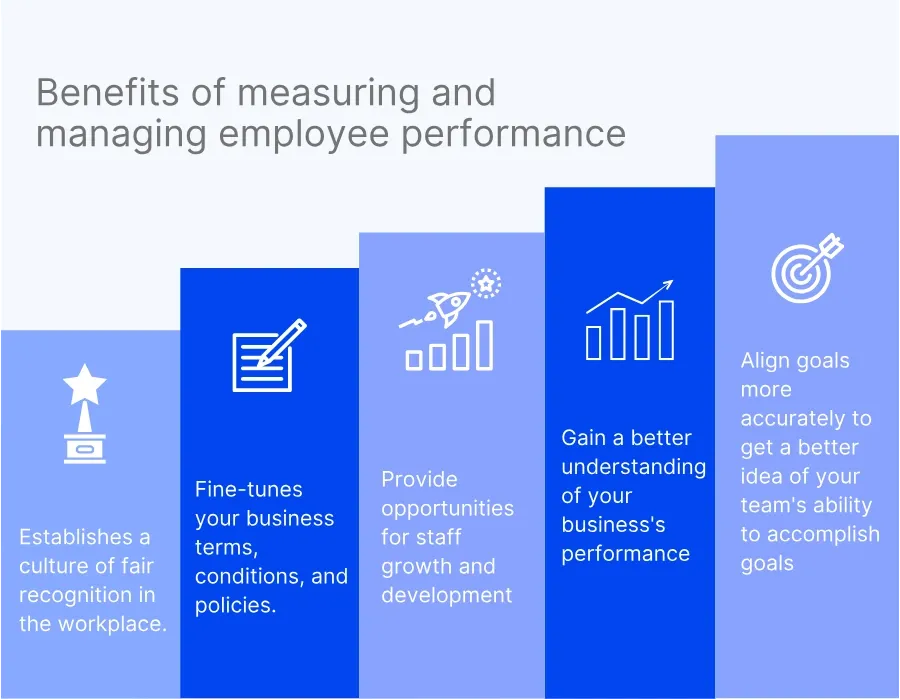Employee Performance Management: Benefits and Tips to Improve It Effectively
Employee performance management means continuously monitoring employees' work to understand whether it aligns with the organizational goals and objectives. Explore this blog to know how to improve employee performance effectively.
On this page
Employee performance management has evolved beyond annual appraisals into a continuous, data-driven approach. Managing employee performance today focuses on real-time feedback, goal alignment, and team collaboration rather than outdated individual assessments.
A McKinsey study highlights the shift from individual-centric performance management to a team-based model, reinforcing the need for organizations to rethink their strategies. Businesses adopting this approach see improved engagement, efficiency, and overall productivity.
To truly understand how to improve employee performance, exploring its benefits, practical implementation strategies, and direct impact on business success is essential.
Let’s get started.
What is employee performance management?
Employee performance management is not just about measuring and improving the performance of the employees. It is also about aligning individual objectives with the organization's and vice versa.
The performance management process is continuous rather than an annual review. The goal of performance management focuses on building your employees' ability to perform their work better. Skills improvement and professional development are both essential parts of performance management.
However, performance management is also a two-way street. You need to gauge whether an employee is a fit for their job and whether the job utilizes the employee's skill set to its fullest. In other words, it involves aligning one's job assignments and skills with the goals of the employee's team and organization.
Benefits of employee performance management

Management expert Peter Drucker once famously said, "What gets measured gets managed." In an age where employers look at performance as more than the revenue their employees bring into the company, this saying is still relevant.
You can't manage something you don't know. Measuring employee performance is the first step in managing and eventually improving it.
Why should your company measure employee performance in the first place? One recent study published by Capgemini argues that employee performance, including productivity and engagement, is closely linked to the employee experience. In other words, high-performing employees and teams work in a high-performance workplace and vice-versa.
Implementing an employee performance management system will benefit your organization in the following ways:
1. Provide opportunities for staff growth and development
As a manager, you can influence your organization's performance by paying close attention to the performance of the people working with you.
However, you must implement an employee performance management system to record and compare your observations to specific growth and development targets. Otherwise, you'll just be making uninformed guesses.
By using an employee performance management system, you'll have all the data you need to identify improvement opportunities and predict your employees' career trajectory.
For example, suppose an employee does poorly in numerical tasks but has excellent communication skills. In that case, you can either train them in numbers or steer them towards a career path that can maximize their strengths.
2. Align goals more accurately
Before setting your goals, you must assess your team's skills, availability, and performance. By measuring and managing employee performance, you better understand your team's ability to accomplish goals. As a result, you can either adjust your goals to account for your team's strengths and weaknesses or hire additional resources to help you reach your targets.
The first step in employee management is recruiting or assigning the right person for the job. It is, therefore, essential to have a holistic approach leveraging business acumen for an effective role assignment process.
Once that is done, you should set performance goals with your new employee with the organization's larger goals in mind. This might not seem easy if the employee works remotely. Still, with constant check-ins and alignment sessions, they will understand how you will monitor their performance for the remainder of the assessment period.
3. Gain a better understanding of your business's performance
People make organizations, and it is their collective performance that drives growth. Therefore, it is easy to understand why you need to measure individual performance to understand organizational performance better.
This is particularly true for small businesses, where the output of a few employees can spell the difference between turning a profit or operating at a deficit. Performing employee appraisals can help you identify top performers and those who need improvement.
It can also help you identify both knowledge gaps that cause your business to perform below expectations and employee capabilities that you can use in the future.
4. Fine-tune your business policies
To build a company culture that attracts and retains great employees, you must combine your employee performance appraisal data with the employee experience. You can collect this at different touchpoints in the employee lifecycle. These points include periodic employee satisfaction surveys and exit interviews.
When you analyze employee experience data in the context of employee performance, you can have a clearer view of the effect of one on the other.
For instance, if an employee says they wish they could have worked remotely more often in their exit interview, you can determine the lack of remote working options and suboptimal performance.
You can also make your analysis as granular as possible to identify previously unknown factors that affect employee performance. For example, a study published by the University of Oxford discovered that more windows (and natural light) in the workplace had a positive effect on sales and efficiency.
You can then use these insights to establish a workplace culture that encourages employees to perform better while maintaining a healthy work-life balance.
5. Establish a culture of fair recognition
Using employee performance reviews, you can establish a culture of fair recognition in your organization. On the one hand, by identifying top performers and rewarding them, you show your workforce that you appreciate and recognize hard work. It is crucial to do this, as employee recognition is the number one factor driving employee engagement and productivity.
On the other hand, an employee lacking in his performance will need closer management. Identifying weak performers on time is important so you can set up a development plan to improve their skills and reduce errors.
If that does not work, you need to decide and communicate the consequences to the workforce to get their act together accordingly. Missing either one of these can have a severe impact on your business.
How do you manage and improve employee performance effectively?
Good performance management entails more than just building a productive workplace. Understanding how to improve employee performance requires leadership, strong social skills, the ability to give constructive feedback, and teamwork—all essential for an effective performance management strategy.
1. Set clear goals and objectives
Without well-defined goals, you and your team will not have an idea of your progress and how much ground you need to cover. Most management experts believe in a few basic principles of goal setting:
These principles provide leaders with a good idea of the goals they need to set for themselves and their teams.
You may also use the SMART criteria while deciding on team goals:
- Specific: What are you looking to accomplish, and what are the steps to it?
- Measurable: What are the key performance indicators of the goal?
- Achievable: Is this goal based upon realistic metrics? Is the employee equipped enough to achieve it?
- Relevant: Does it fit well in the employee's overall work profile and company priorities?
- Time-based: What are the deadlines for each goal?
Here is an example of a SMART goal board from Hubspot -
Goal setting is essential for managing employee performance in any team but is even more crucial for remote teams. Remote teams may feel completely lost if they are not given a clear direction in terms of the goals and objectives of a company, as they are not communicating with their core team every day.
The goals you set for your employees will depend on their line of work. For example, if you employ graphic designers, you can gauge their work's quality and adherence to branding guidelines. If you manage a data analysis team, you can use data quality metrics as your basis for performance management.
2. Use software for performance management
You need a way to track progress efficiently, and ideally, the information you are gathering should be accessible to everyone. Using Google Sheets or Microsoft Excel is not uncommon for employee management, but dedicated performance management software will make things easier and more streamlined for you.
Real-time management: Some tools may offer the capability to monitor your team's performance in real-time, often through features like time tracking or integration with time tracking apps. It allows you to gain immediate insights into your team's productivity, project status, and individual contributions.
Here are some factors to consider when choosing employee performance management software:
💸 Cost: Enterprise-level software, such as SuccessFactors or Workday, might be out of your budget. You can use performance management software targeted towards small businesses instead.
🔗 Features and integrations: Most employee performance management software have some level of integration with other HR-related systems, including payroll and employee recognition solutions. These integrations will streamline the experience for your employees and the HR team.
🔧 Ease of use and training: Performance management software has many moving parts, and getting lost in all the features is quite easy. Aim for simplicity when you're looking for a system for your team.
Most software for employee performance management has a flexible approach and can build dashboards per your specific needs. You may try out demos to choose the right product.
3. Provide regular performance feedback
Providing relevant and regular feedback 📝 is an essential element of performance management. It can take many forms:
- Managers give feedback to employees as part of a performance review.
- Employees provide feedback to their managers.
- Implementing peer-to-peer feedback.
You might wonder how frequently you should provide feedback.
However, the type of feedback millennials consider meaningful does not fit squarely into the categories found in typical periodic assessment sessions. Instead, the discussions should focus on recognition, career direction, and employee emotions, particularly in times of uncertainty such as a global pandemic.
Also, how you give feedback can change the results to a large extent. For example:
- Instead of saying something didn't work, explain why and place it within the larger context of the business.
- Instead of saying "good job", say what worked.
- Instead of dwelling on what went wrong, invite the employee to discuss what they can do better in the future.
Instead of talking like a boss, talk like a team member and avoid adverse and judgmental phrasing. Good performance management software comes in handy in managing feedback effectively.
4. Provide them with adequate work equipment
Providing the right resources boosts workplace efficiency and overall performance. Adequate work conditions also play a crucial role—office setup influences behavior, productivity, and morale.
Lack of proper equipment affects performance and compromises safety. Cutting corners on essential tools can lower morale and increase turnover. In physically demanding roles, quality equipment reduces injury risks, reinforcing ethical employer practices.
Some tools enhance efficiency, while others minimize time spent on repetitive tasks. Proper hardware and licensed software are essentials. For teams needing seamless communication, reliable tools improve workflow—meanwhile, employees handling written content benefit from supportive service providers.
5. Identify emotional vampires
Some people simply draw the life force from everyone in their vicinity. They’re not directly impacting productivity by underperforming or sabotaging the rest of your team, but they might undermine the office’s morale daily. It is necessary to provide a healthy work environment.
Studies even suggest that these individuals have a much more profound impact on their coworkers than was previously assumed.
The problem in spotting these individuals may lay in two things.
- Your employees might be reluctant to bad-mouth their coworkers (even if they dislike working with them).
- They aren’t necessarily underperforming or performing poorly in your employ.
So, make sure that you develop an efficient feedback system and have the trust level with your employees so high that they’ll feel comfortable telling you these things.
Once you identify the emotional vampire, you can do two things.
- Fire them not to have them undermine the productivity of your entire staff.
- Offer them a chance to work from home or place them in a position where they have as little interaction with the rest of your team as possible.
The first option is much more reliable because an emotional vampire can still substantially damage office morale, even in the virtual environment.
6. Show your team that you care about them
Many entrepreneurs assume the customer-is-always-right principle applies universally, but that’s not always true. If a customer is rude or unreasonable, they may not be worth the effort to retain. Trying too hard to keep them can drain resources and demoralize your team—a concept known as customer bullying. Prioritizing toxic customers over employees can hurt productivity and morale.
One of the best ways to show employees they matter is by making time for them. While your team is small, regular one-on-one meetings can be invaluable. These sessions help you align on priorities, address concerns, and reinforce that their contributions are valued.
Author Elizabeth Grace Saunders highlights that personal attention from leadership fosters loyalty and engagement like nothing else. Simple actions—asking about project progress, remembering personal details, or supporting team collaboration—go a long way. Leadership is more than managing tasks; it’s about building relationships that drive success.
7. An adequate reward for an adequate effort
It is only natural that people are more interested in what they can do for them than what they can do for you, which is why you need to start considering the intrinsic motives of your team.
First, people care about their finances, which is why the promise of a raise is compelling. Second, those who are more career-oriented may focus on the ability to rise in the ranks, which is why some room for vertical movement may also work.
While the above-listed two may be great for one’s short-term motivation, the short-term motivation of your staff on a project may also be a thing worth considering. This is what the bonuses are there for.
This is particularly effective when your team is just wrapping up a major project, and you expect them to start another one just as they’re done. By handing them out a bonus, you’ll remind them why they’re working extra hard to deliver you results. On the other hand, some studies claim otherwise.
8. Invest in employee development
More competent employees equal a more productive workforce. To ensure your team is always ready to tackle any challenge and keep up with the innovations in the industry, investing in employee learning and development is the best course of action.
Although this seems like a costly solution for some business owners, it’s a practice that will surely help your company move forward.
Courses, seminars, workshops, and mentoring programs will help your employees grow professionally, making them more skilled, efficient, and productive in the workplace.
9. Motivate using incentives
Incentives are a great way to reward the most productive employees for well-done jobs, and they show the whole team you value their hard work and contributions.
Incentives can include various benefits, from paid time off, bonuses, and raises to organizing team-building activities where your staff can relax and get to know each other better.
10. Organize regular performance reviews
Scheduling regular employee evaluations give the management valuable opportunities to provide individual feedback for every team member.
However, these meetings are also helpful in finding out what troubles your employees, what they might miss in the workplace, and what would make them more motivated and driven to fully commit to their everyday tasks
11. Stay in the loop and communicate openly with your team
Boosting employee engagement and performance is a process that requires long-term dedication and attentiveness.
To make sure your employees understand their assignments and do their best to accomplish them in the most effective and timely manner, stay in the loop and openly communicate with your team.
12. Team and community building
Another thing you need to keep in mind is that loyalty is an effective motivator, even if it’s not just you that your team members are loyal to.
Remember that working on a project with people they hold in high esteem might place your employees in a position where they feel the pressure to work extra hard not to let their team members down.
In this particular case, validation of their peers means more than any kind of positive feedback on your side. This is a benefit of being in a harmonious and well-composed team.
Achieving this, on the other hand, takes a lot of effort on your part.
- It requires you to provide your team with some team-building activities and opportunities.
- It requires you to allow your staff to mingle outside of work. We’re talking about field trips, corporate parties, and other opportunities for them to get to know each other in a bit more relaxed environment.
- Most importantly, you need to make your office an environment where making friends is easy and possible.
Being constantly under pressure and feeling monitored/supervised will kill this vibe around the office. Make sure that your team members feel pleasant in the office, and the team unity will skyrocket in no time.
The last thing you need to focus on is rewarding teamwork instead of individual effort. Backstabbing and undermining colleagues due to rivalry will only happen if you make the environment in which these practices give results.
The numbers here are pretty shocking, seeing as how 29% said that there is someone at their workplace who is making their lives a living hell, and 14% claimed more than one person is making their lives miserable.
To make matters worse, this starts a vicious cycle, seeing as how about 31% of test subjects are keen to get revenge on someone who did them harm, thus escalating the matters further.
You'll create a team-friendly environment by rewarding teamwork instead of praising only the staff members who are constantly there for others.
Remember that you can expect your employees to continuously act like this if you endorse backstabbing behavior in your office. In other words, you can’t expect to reward such behavior and then act surprised once it takes over your office.
How to improve employee performance with Empuls

Good performance management entails more than just building a productive workplace. Establishing an effective employee performance management strategy requires leadership, strong social skills, the ability to give constructive feedback, and teamwork. Empuls enhances this process by providing tools that foster meaningful reviews and continuous improvement.
✔ Gather comprehensive feedback: Use Empuls' 360° feedback surveys to collect insights from managers, peers, and subordinates, ensuring well-rounded performance evaluations.
✔ Leverage data-driven insights: Empuls' HR People Analytics offers real-time performance data, helping leaders make informed decisions and drive employee growth.
✔ Monitor engagement levels: Keep a pulse on employee sentiment with real-time surveys, allowing proactive support to maintain high performance and morale.
A structured, insightful review process improves employee performance and fosters long-term success. Empuls helps organizations build a culture of feedback, growth, and continuous development.
Closing
It is clear now that the benefits of measuring and managing employee performance take care of more things than one can imagine. The entire work environment is uplifted from employee development, improved relationships between managers and employees, synergy between teams, hitting targets, and beyond.
So, if you are wondering how to manage employee performance effectively, you can now start building a robust process and make it as continuous as it is supposed to be.















